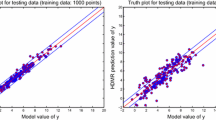Abstract
The problem of predictive diagnosis based on laboratory data is approached from a mathematical standpoint. A descriptive system is introduced which examines the current information about a clinical problem and identifies best predictors of the problem. Algorithms are described for the assessment of current diagnostic ability, the evaluation of new laboratory tests, and the identification of patients to study for the development of new procedures. The laboratory approach to the predictive diagnosis of iron deficiency is chosen as an example of the system.
Similar content being viewed by others
References
Grams, R. R., Johnson, E. A., and Benson, E. S., Laboratory data analysis system I-VI.Am. J. Clin. Pathol. 58:177–219, 1972.
Winkel, P., Patterns and clusters-multivariate approach for interpreting clinical chemistry results.Clin. Chem. 19:1324–1329, 1973.
Truett, J., Cornfield, J., and Kennell, W., A multivariate analysis of the risk of coronary heart disease in Framingham.J. Chron. Dis. 20:511–524, 1967.
Glick, J. H., Serum lactate dehydrogenase enzyme and total lactate dehydrogenase values in health and disease and clinical evaluation of these tests by means of discriminant analysis.Am. J. Clin. Pathol. 52:320–328, 1969.
Amenta, J. S., and Harkins, M. L., The use of discriminant functions in laboratory medicine. Evaluation of phosphate clearance studies in the diagnosis of hyperparathyroidism.Am. J. Clin. Pathol. 55:330–341, 1971.
Werner, M., Brooks, S. H., and Cohnen, G., Diagnostic effectiveness of electrophoresis and specific protein assays, evaluated by discriminate analysis.Clin. Chem. 18:116–123, 1972.
Baron, D. N., A critical look at the value of biochemical liver function tests with specific reference to discriminant function analysis.Ann. Clin. Biochem. 7:100–108, 1970.
Ramsoe, K., Tygstrup, N., and Winkel, P., The redundancy of liver tests in the diagnosis of cirrhosis estimated by multivariate statistics.Scand. J. Clin. Lab. Invest. 26:307–312, 1970.
Solberg, H. E., Skrede, S., and Blomhoff, J. P., Diagnosis of liver disease by laboratory results and discriminant analysis: Identification of best combination of laboratory tests.Scand. J. Clin. Lab. Invest. 35:713–721, 1975.
Sher, P.P., Diagnostic effectiveness of biochemical liver function tests, as evaluated by discriminant function analysis.Clin. Chem. 23:627–630, 1977.
Goldman, L., Caldera, D. L., Nussbaum, S. R., et al., Multifactorial index of cardiac risk in non-cardiac surgery.N. Engl. J. Med. 297:845–849, 1977.
Wagner, T., Tautu, P., and Wolsen, U., Problems of medical diagnosis—a bibliography.Meth. Inform. Med 17:55–74, 1978.
Beck, J. R., Cornwell, G. G., and Rawnsley, H. M., Multivariate approach to predictive diagnosis of bone marrow iron stores.Am. J. Clin. Pathol., 70:665–670, 1978.
Beck, J. R., French, E. E., Brinck-Johnsen, T., et al., Ferritin combined with other laboratory tests in the predictive diagnosis of bone marrow iron stores. Acad. Clin. Lab. Phys. Sci. annual meeting, 1978. (abstract)
Cooley, W. W., and Lohnes, P. R.,Multivariate Data Analysis, Wiley, New York, 1971, pp. 49–59.
Tukey, J.,Exploratory Data Analysis, Addison-Wesley, Reading, Massachusetts, 1977, pp. v-viii.
Anderberg, M. R.,Cluster Analysis for Applications, Academic Press, New York, 1973, pp. 131–151.
McGee, V. E., The multidimensional scaling of elastic distances.Br. J. Math. Stat. Psych. 19:181–186, 1966.
Cooley, W. W., and Lohnes, P. R.,Multivariate Data Analysis. Wiley, Proc. Royal Soc. London 184:421–432, 1973.
Gleser, M. A., and Collen, M. F., Toward automated medical decisions.Comput. Biomed. Res. 5:180–189, 1972.
Horrocks, J. C., McCann, A. P., Staniland, J. R., et al., Computer aided diagnosis: Description of an adaptable system and operational experience with 2,034 cases.Br. Med. J. 2:5–9, 1972.
Knill-Jones, R. P., Stern, R. B., Grimes, D. H., et al., Use of sequential Bayesian model in diagnosis of jaundice by computer.Br. Med. J. 1:530–533, 1973.
Lipkin, M., Engle, R. L., Flehinger, B. J., et al., Computer-aided diagnosis of hematologic diseases.Ann. N. Y. Acad. Sci. 161:670–679, 1969.
Rifkin, R. D., and Hood, W. B., Bayesian analysis of electrocardiograms in exercise stress testing.N. Engl. J. Med. 297:681–685, 1977.
Galen, R. S., and Gambino, S. R.,Beyond Normality: The Predictive Value and Efficiency of Medical Diagnoses. Wiley, New York, 1975, pp. 50–51.
Beck, J. R., French, E. E., Brinck-Johnsen, T., et al., Ferritin and mean corpuscular volume in the evaluation of patients for iron deficiency, in preparation.
Author information
Authors and Affiliations
Rights and permissions
About this article
Cite this article
Beck, J.R., Rawnsley, H.M. A multivariate data reduction system. J Med Syst 2, 171–180 (1978). https://doi.org/10.1007/BF02222317
Issue Date:
DOI: https://doi.org/10.1007/BF02222317




